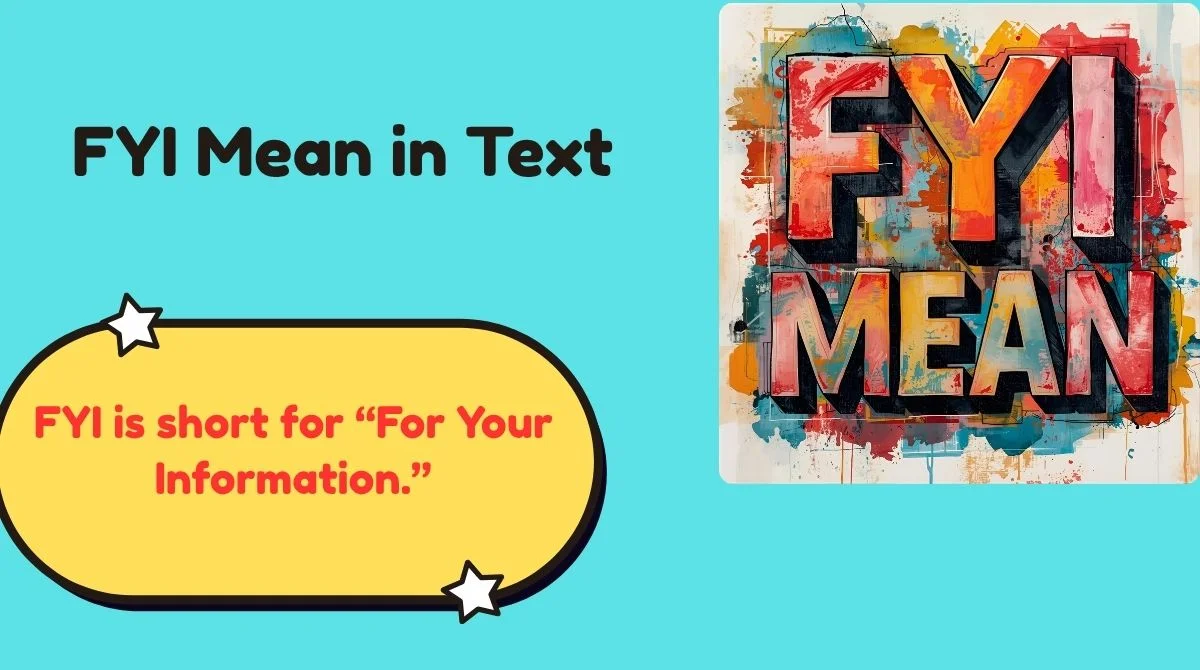In today’s fast-paced digital world, acronyms dominate our texts and emails. One abbreviation that pops up constantly is FYI. But what does FYI mean in text, and how should you use it? Is it always polite, or can it come across as rude?
Whether you’re texting a friend, sending an email to a boss, or replying to a client, understanding FYI is crucial.
This guide dives deep into the meaning, proper use, alternatives, and common mistakes, so you can communicate clearly without unintentionally offending anyone.
What Does FYI Stand For in Text?
FYI is short for “For Your Information.” At its core, it’s a way to pass on information without expecting a reply. It’s been around since the days of memos and office emails but has made its way into everyday texting and messaging apps.
Here’s a quick example:
- Text: “FYI, the meeting has been moved to 3 PM.”
- Meaning: The sender is informing you without asking for a response.
FYI can be professional, casual, or even passive-aggressive depending on tone and context. Knowing the difference is key.
How FYI Is Used in Text Messaging & Emails
FYI can fit many contexts. Here’s a closer look at how it’s typically used:
Professional Communication
In the workplace, FYI is often a neutral way to share information.
Examples:
- Email: “FYI, the report deadline is tomorrow.”
- Slack: “FYI, the client approved the changes.”
Tips:
- Use FYI for updates that don’t require action.
- Pair with a friendly tone to avoid sounding abrupt.
Casual Conversations
Friends and family also use FYI, often in a light or humorous way.
Example:
- Friend: “FYI, I got the last slice of pizza 😆.”
Here, FYI conveys information without pressure—it’s playful rather than formal.
Passive-Aggressive Uses
Sometimes, FYI can come off as rude. This usually happens when the sender’s tone is curt or when important context is missing.
Example:
- Text: “FYI, you missed the deadline.”
- Tone: Blameful, dismissive, or scolding
Recognizing these cues helps prevent misunderstandings.
Is FYI Rude or Impolite?
Whether FYI is rude depends entirely on context, tone, and punctuation.
- Neutral: “FYI, the document is attached.”
- Potentially rude: “FYI. You were supposed to send this yesterday.”
Simple changes like adding “just” or “thought you might like to know” can make a world of difference.
Key takeaway: FYI itself isn’t inherently rude. It’s the tone, delivery, and audience that matter.
Polite & Professional Alternatives to “FYI”
Sometimes, FYI can feel too abrupt or cold. Here are polite alternatives that convey the same meaning but soften the tone:
| Alternative Phrase | Best Use Case | Tone |
|---|---|---|
| Just so you know… | Informal updates | Friendly |
| For your reference… | Professional emails | Neutral |
| In case it’s helpful… | Suggestions or tips | Supportive |
| Thought you might like to see this… | Sharing info | Warm |
| Just bringing this to your attention… | Formal notices | Polite |
| You might find this useful… | Helpful info | Friendly |
| This may be of interest to you… | Professional or casual | Neutral |
| A quick heads-up… | Casual alerts | Informal |
| Wanted to make you aware… | Neutral or formal | Polite |
| Please note… | Formal updates | Direct |
Using these alternatives allows you to customize tone, reduce ambiguity, and sound more considerate.
15 Advanced-Level Examples of “FYI” Alternatives in Use
- Email to boss: “For your reference, the quarterly report is attached.”
- Text to friend: “Just so you know, the concert tickets are sold out.”
- Slack message: “In case it’s helpful, I’ve included the client’s feedback.”
- Professional chat: “Thought you might like to see this new marketing idea.”
- Notification to team: “Just bringing this to your attention: the meeting location changed.”
- Casual text: “You might find this useful: the new app update is live.”
- Work email: “This may be of interest to you: our competitor launched a new product.”
- Team chat: “A quick heads-up, the deadline is tomorrow.”
- Client email: “Wanted to make you aware of the updated terms.”
- Formal memo: “Please note the new office hours.”
- Group text: “FYI, we’re meeting at 6 PM instead of 7.”
- Professional message: “For your reference, here’s the link to the report.”
- Casual note: “Just so you know, the store closes early today.”
- Manager message: “In case it’s helpful, I’ve outlined the next steps.”
- Team update: “Thought you might like to see this chart of last month’s sales.”
These examples show how context and phrasing can completely change the tone of a simple FYI.
How to Choose the Best Alternative to “FYI”
When deciding between FYI and its alternatives, consider:
- Audience: Colleague, client, friend, or manager
- Tone: Friendly, neutral, professional, or urgent
- Purpose: Inform, alert, or suggest
General Rules of Thumb
- Use FYI sparingly in casual conversations.
- Use polite alternatives for formal or professional texts.
- Include context or action steps when needed.
- Avoid overusing FYI in the same conversation.
Common Mistakes When Using FYI in Text
Even small missteps can make your message appear rude or careless. Common mistakes include:
- Using FYI without context
- Sending FYI to someone who needs action, not just information
- Overusing FYI in long threads
- Using FYI in sensitive situations where tone matters
- Forgetting punctuation or adding abrupt periods
Example of mistake:
FYI. You didn’t reply to the email.
Better alternative:
Just bringing this to your attention, I noticed the email hasn’t been replied to yet.
FAQs About FYI
What does FYI mean in text messages?
FYI stands for “For Your Information” and shares information without expecting a reply.
Is FYI rude in texting?
It can be if the tone is abrupt or dismissive, but it’s not inherently rude.
What is a polite alternative to FYI?
Alternatives include “Just so you know…”, “For your reference…”, or “Thought you might like to see this…”
Can I use FYI in professional emails?
Yes, FYI is common in professional emails, especially for updates that don’t require action.
How do I avoid sounding rude with FYI?
Add context, soften the tone with words like “just” or “thought you might like to know,” and consider your audience.
Summary: Mastering the Use of FYI and Its Alternatives
FYI is a versatile abbreviation, but its tone changes based on context, punctuation, and audience. By understanding its nuances and using polite alternatives, you can communicate clearly and professionally.
Remember these key points:
- FYI = For Your Information, usually no reply expected
- Tone is everything: neutral, friendly, or potentially rude
- Use alternatives for softer communication
- Check context and audience before texting FYI
With these tips, you’ll be able to use FYI confidently without creating misunderstandings or coming off as curt.











